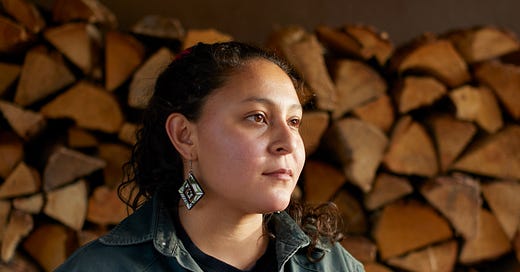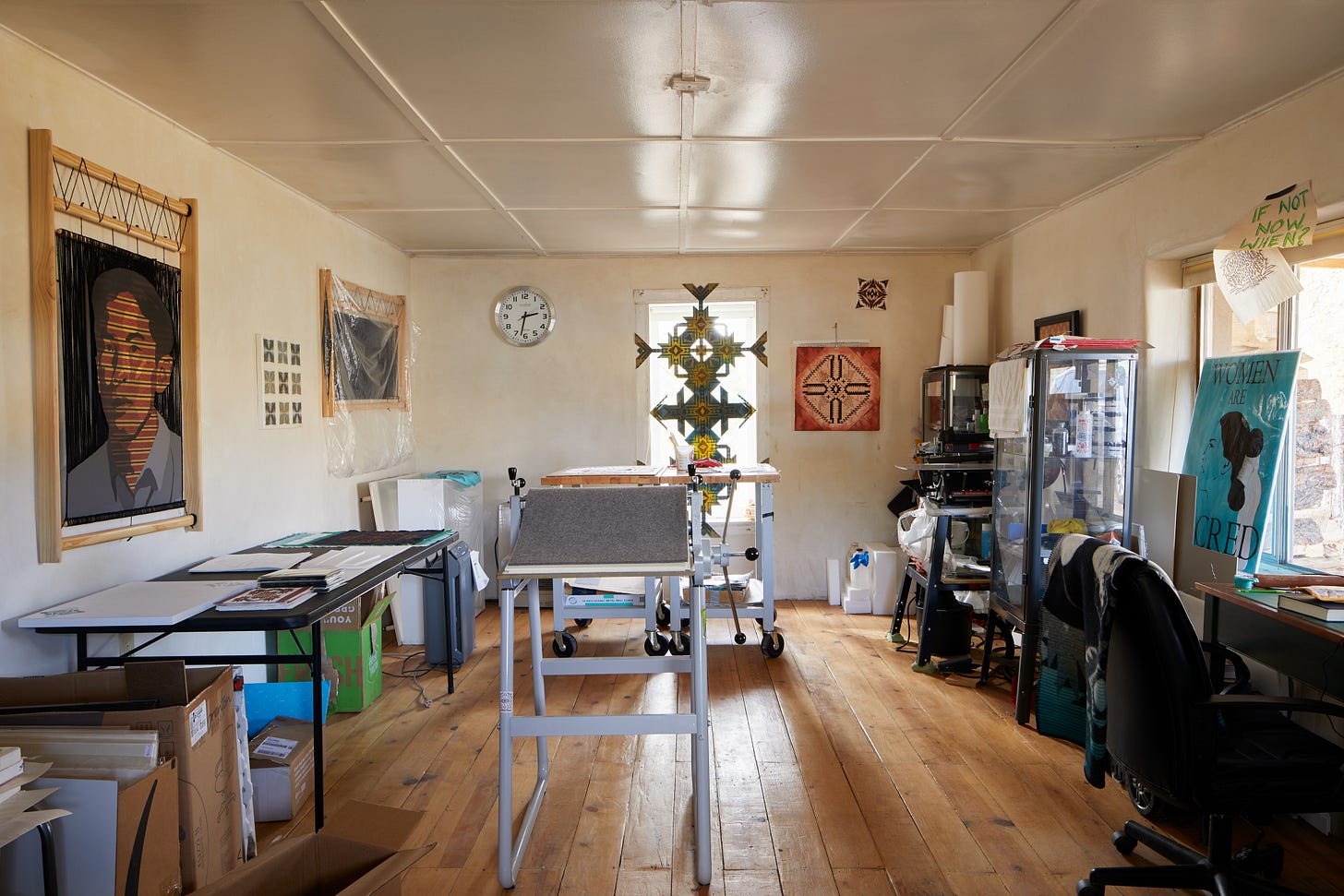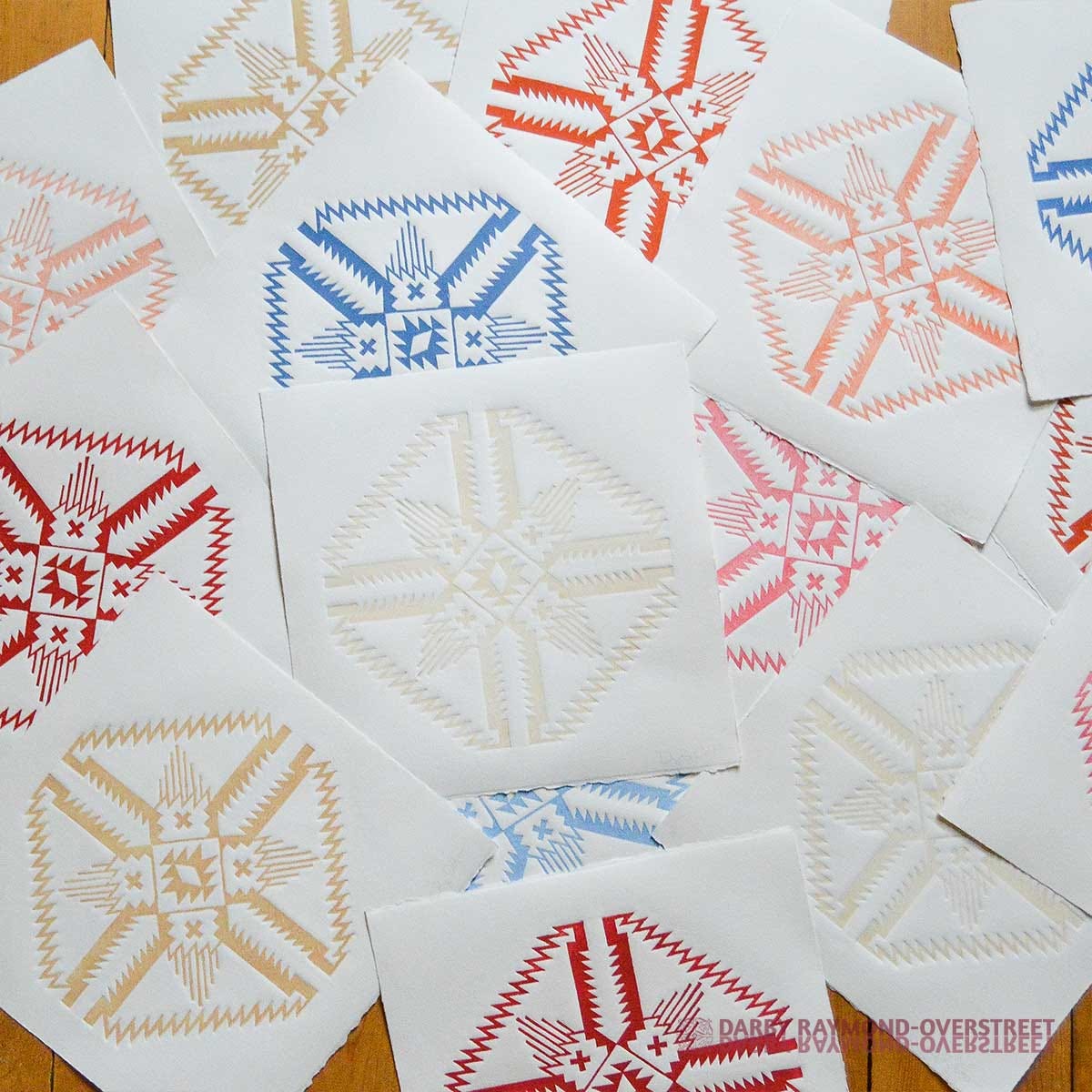A Conversation with Darby Raymond-Overstreet, Diné Artist and Printmaker
Traditional Diné textiles influence her artwork
Darby Raymond-Overstreet is a digital artist and printmaker based in Chimayó, New Mexico. She uses her work to spotlight Diné people and culture, and bring representation to her heritage. Darby uses the designs and patterns of traditional Diné textiles from the 1800s to the 1950s to inform her work, whether it be of landscapes, portraits, or abstract forms. The work in her portfolio varies widely: Some pieces are whimsical, some are more serious; some are colorful, some are more muted. All are exquisitely detailed and powerful.
I was introduced to Darby for a piece I wrote about Indigenous designers in the outdoor industry. In this interview, Darby shares more about her inspiration, path to becoming an artist, mission behind her work, a day-to-day range of her energy, and her favorite way to recharge.
How do you describe your craft?
I work in all types of mediums. I’m probably most well known for my digital mixed media work and printmaking. And for that work, I’m inspired by Navajo/Diné textile designs and patterns. I use the designs to create portraits, landscapes, and different abstract forms. But I also do beadwork, and I love to draw. I do all types of art but everything is derived from my own connection to my heritage and my life experience. I’m really inspired by all the people I know—my friends, my family, my community.
How did you start out as an artist?
I’ve always liked art and creating. I attribute that to my dad. He’s not a professional artist, but he’s really talented at rendering photorealistic drawings using graphite and pencil. Some of my earliest memories are sitting in my dad’s room, and he’s at his drafting table working on a portrait. He’s using a 6x8 photo to create a big 36x36 portrait. I always thought it was so cool how he could really bring portraits to life. I really wanted to be like my dad. In Native American arts, it seems like a lot of artists come from families of artists, whether that be jewelry makers or painters or photographers. My story is a little bit different in that I didn’t come from professional artists. For my dad, it was a hobby. He was actually a physical therapist and now he’s a hospital administrator. My mom is a biologist. I always thought I would follow in their footsteps, but I held onto art and my own aspirations to exercise my imagination and creativity. I liked school. I liked learning. But art classes were my favorite subject. When I got into college, I kept taking art classes and my path became clearer from there.
See more of Darby’s art on her website, darbyraymond-overstreet.com.
What or who encouraged you to pursue art as a career?
When I went to college, I didn’t think I would pursue art as a career. I studied psychology and double majored in studio art. With my psychology degree, I had intended to return home and do some counseling in my community. I was doing work in suicide prevention for Northern Arizona and New Mexico. I was really passionate about that and I feel like that’s much needed work. But ultimately, I felt that there were other ways to tackle the same issue. In my art classes, I was talking a lot about Native Identity and representation. It just became clear to me that the best way I could help my community or be a role model was to pursue my own dreams. I also had a professor who pushed me to keep working on pattern portraits. She really was the one who told me I could pursue it as a career. That meant the world to me. At the time, I was kind of meek about art with my family. They thought it was cool, but until I got that type of confidence and affirmation, I didn’t feel like I could really be that open and claim that I’m an artist. Once you say that, it feels like you’re baring your soul to the world or something.
You said you use your work to help your community. What’s the mission behind your pieces?
A big part of my work is about combatting stereotypes and cultural appropriation. That really takes a toll on people and communities and their sense of self and self-worth. I did work in suicide prevention in Native communities specifically, and people just felt invisible and like they didn’t matter. That was just heartbreaking. It’s a tough subject, but through my work I’m really trying to portray an honest and true picture of who we are as Diné people, our values, our rich culture, our stories, and our lived experience. We are beautiful, and we come from beauty. My aim is to represent Native people and put myself out there to follow my own path. I’m young, but there are even younger eyes on me. I have six brothers, I have cousins, my friends have kids. So it’s important to me to do the best I can with what I’ve got and help people be seen.
I’m sure your workday changes day to day, but what’s an ideal work situation for you?
What is ideal differs from what actually happens. I think I fluctuate between the two. Sometimes I have great days and then sometimes things do not go how I planned. Ideally, I work from a calendar. In January, I plan out what I hope the year would look like. It’s harder to do that especially now with the pandemic, but I’ve got loose goals. There’s a lot of flexibility, but each month I hone in on working toward the overall goal and working in little steps. Some days I don’t reach my goals and then other days I’m almost in a frenzy. I’m just so prolific in what I’m doing. I think overall it balances out. I always write down all the things I accomplished so I can affirm myself and stay on the path.
What does that frenzy look like for you?
I usually like to get my day started early. When I wake up, I do some exercises and then I journal. Some days, it already starts to feel like a slow day. And then other days, the frenzy days, I have all the energy in the world and I want to do all of these things. I start on one project or one task. And then halfway through that task, I start a second task and then a third one comes in. On a normal day, I’ll do 5 to 7 things. On frenzy days, I’ll have a list of 15 or so. I’m just constantly working and intensely focused. I won’t really be on my phone. My studio is in my home so that makes it easy.
What are some ways you sustain your life as an artist?
I rely on multiple sources of income. I have a part-time job at the Institute of American Indian Arts that is probably the most stable aspect of my income. I get paid every two weeks guaranteed. I also have an online store and I sell my artwork, usually through people contacting me directly. I’ve been doing virtual markets this year, which is how I’ve sold many pieces. When there’s no pandemic, I go to art markets and I have a booth. I like to meet the people who buy my art. And then I apply for grants too. For me personally, money isn’t what it’s all about. I just like to sustain myself and my needs. But as long as I’ve got those things covered, I feel like I’m in a pretty good place and I can create.
For behind-the-scenes updates on Darby’s work, follow her on Instagram.
Do you find creative inspiration at the institute?
Oh yeah, absolutely. I mostly work at the museum store. We sell tickets to the museum, but we also have the unique opportunity to promote and present our audience with Indigenous business, whether that be jewelry, art, apparel, or lotions. We try our best to give people the option to buy Native, if that option exists. That’s really inspiring for me. And then just being at the museum, we have fantastic shows. It’s all contemporary Native art, so when I’m there I usually just go into the galleries on my breaks and look at really interesting and beautiful art. It’s a great opportunity. I wouldn’t want to work anywhere else.
Where else do you find inspiration? Do you have some favorite ways of drawing that out of yourself?
I’m fortunate to be around some of the great conversationalists, so I certainly find inspiration from the things we talk about, especially with my partner. Anyone who knows her knows she is a fantastic conversationalist. We talk about all the issues. I definitely generate inspiration just through conversation. But I also really like listening to podcasts and watching TV shows, especially competitive art shows like tattooing or even those cake-building competitions. I love watching someone creating on the spot. That’s just pure creativity. I really like watching Blown Away, which is about glass blowing, and Forged in Fire, which is mostly dudes making knives and swords. I’m also part of different Facebook groups for printmakers, paper makers, and woodworkers. I see a lot of awesome things in those groups, whether it’s a troubleshooting issue or a new technique.
When you’re not working on art, what’s your favorite way to self-care?
There’s definitely times where I do need that break, especially if I’m going on a couple weeks of creating. The best thing that I do is journal. That’s a daily practice. I’ll do it for maybe 5 or 10 minutes in the morning, but if I’m needing more of a break or just time to regather my thoughts, I’ll journal for as long as I need to. I live out in the country in this hilly area. There are badlands, so it’s a wonderful place for hiking. I have a dog and she’s a great companion on our hikes. I find that exercising, getting into movement is almost like meditation. It just makes me feel good.
Can you explain what your work means to you?
My work is just a huge facet of who I am. It’s my life. When you’re putting your work out there and you’re saying you’re an artist, it really does feel like you’re baring your soul. That’s exactly how I feel about my work. It’s so much of my growth. It’s so much of my hopes and my dreams. It’s how I connect to people. It’s the best way in which I can communicate. It’s how I live my truth.
Before you go…
Register: Free science and nature writing masterclasses (Pandemic University)
Read: A Q&A with Ann Friedman about the newsletter revolution (Deez Links)
Watch: DIY notebooks from scratch (Nianiani)









